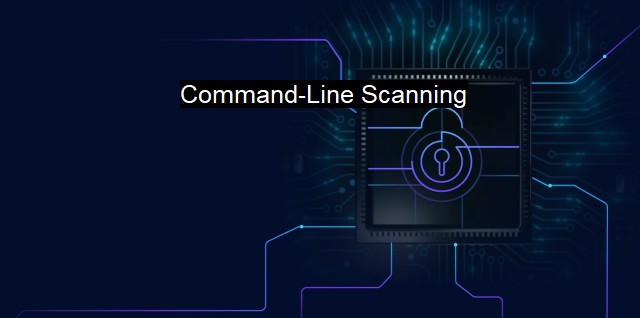What is Command-Line Scanning?
Exploring the Necessity of Command-Line Scanning in Antivirus and Cybersecurity Software: An In-Depth Look
Command-line scanning is a powerful and flexible approach to identifying and managing potential threats to computer systems. It enables users to conduct extensive scans of computer systems without the need for a Graphical User Interface (GUI).In simple terms, the "command line" is the text interface that enables interactions between users and the software. Users enter the required commands in the form of textual lines. Based on these inputs, various operations are executed, including launching applications, manipulating files, and other similar operations.
Command-line scanning, therefore, involves running a scan of the computer system by inputting specific commands. The details of the commands vary based on the specific antivirus or cybersecurity tool being used. the ultimate objective is to scan the computer system in order to identify security threats, irrespective of where they may be hidden within the system.
In order to use command-line scanning effectively, it is necessary for the user to have a deep understanding of the command syntax and scripting language specific to the cybersecurity tool. The technique provides an enormous degree of flexibility and control, greater than that offered by GUI-based tools, as users can specify precise parameters and configurations for the scan.
The accuracy and efficiency of command-line scans make them indispensable in scenarios where vast networks of computers need to be vigilantly monitored. It cuts down on the processing power and time required by removing the need for visual rendering and the overhead associated with GUIs, thus making scanning more streamlined and efficient.
Command-line scanning is often used as part of a broader strategy in antivirus and cybersecurity software. It allows advanced users to undertake rigorous scans on practically any part of their systems ranging from individual files or directories up to the entire computer ecosystem. One common use case is in server configurations, where servers require periodic scans to detect malware or other potential threats.
Command-line scans can be automated, allowing for comprehensive scans to be run at user-defined intervals or timely response to newly identified threats. Users can set up scheduled scans in advance, configuring the requisite commands to run seamlessly in the background. This is particularly useful in an enterprise setting where maintaining optimal system security and reducing downtime are critical.
The results from these scans typically appear in text format, allowing advanced users to redirect these results to log files. Analyzing these log files can provide crucial insights into the vulnerabilities and threat landscape faced by the system. Also, script-savvy administrators can use the output of the scan as an input for another script, enabling the automation of responses to the identified threats.
Command-line scanning comes with its own challenges. For beginners or users unfamiliar with command-line interfaces, this method of scanning could be a bit complex in contrast to the intuitiveness of GUI-based cybersecurity tools. Even minor errors in the commands can result in scan failures or incorrect results. Ensuring comprehensive training and abundant documentation are essential to overcome these hurdles.
Understanding the many facets of command-line scanning is crucial for any comprehensive cybersecurity strategy. Its usage extends far beyond manual input of commands, offering powerful possibilities for automating and optimizing the detection, scanning, and removal of digital threats. While it may initially seem daunting to some, the potential benefits of command-line scanning in terms of flexibility, customization, and scalability make it an indispensable tool in the ever-complex world of cybersecurity.

Command-Line Scanning FAQs
What is command-line scanning?
Command-line scanning is a process of scanning files or folders for malware or viruses using antivirus software from the command prompt rather than a graphical user interface. It allows for more advanced and efficient scanning options and can be especially useful for cybersecurity professionals.How does command-line scanning differ from traditional antivirus scans?
Command-line scanning differs from traditional antivirus scans in that it is done entirely through the command prompt, allowing for greater customization of scanning options and the ability to scan multiple files and directories at once. Traditional antivirus scans are usually done through a graphical user interface and may not offer as many scanning options.What are some benefits of using command-line scanning?
Some benefits of using command-line scanning include the ability to scan multiple files and directories at once, greater customization of scanning options, more efficient use of system resources, and the ability to automate scanning tasks. It also allows for easier integration with other security tools and can be used to create scripts for automated scanning.What precautions should be taken when using command-line scanning?
As with any security tool, it is important to use command-line scanning responsibly and with caution. It is recommended to run scans on a regular basis, keep antivirus software up to date, and use trustworthy software from reputable sources. Users should also be aware that some malware may be specifically designed to evade detection by antivirus software and should not rely solely on scanning to protect their systems.| | A | | | B | | | C | | | D | | | E | | | F | | | G | | | H | | | I | | | J | | | K | | | L | | | M | |
| | N | | | O | | | P | | | Q | | | R | | | S | | | T | | | U | | | V | | | W | | | X | | | Y | | | Z | |
| | 1 | | | 2 | | | 3 | | | 4 | | | 7 | | | 8 | | |||||||